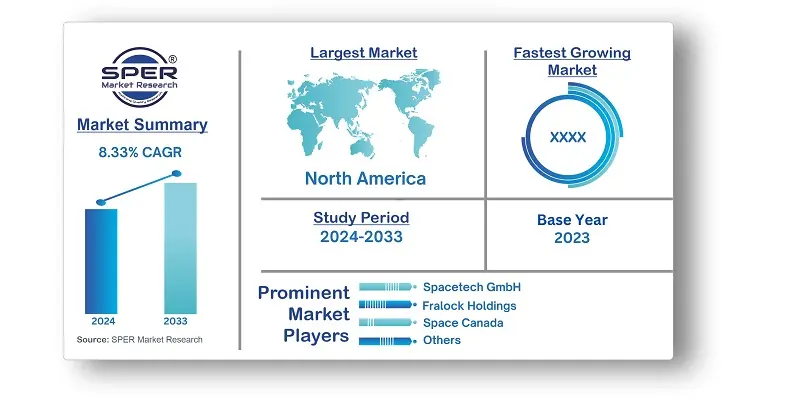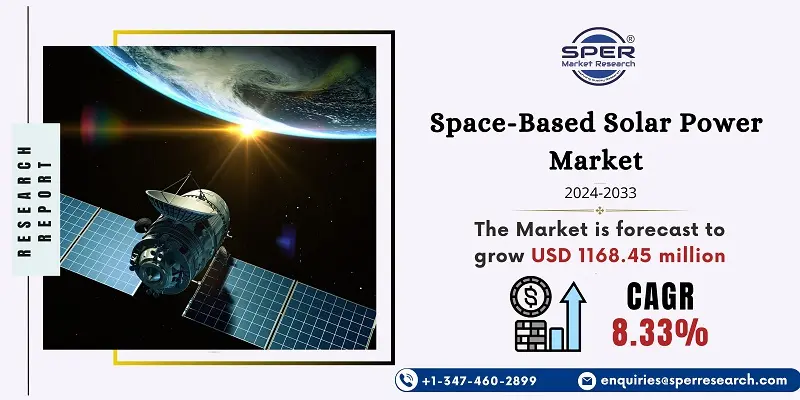
Space-Based Solar Power Market Growth, Size, Trends, Share, Demand, Revenue and Future Outlook
Space-Based Solar Power Market Size- By Solar Satellite Type, By Application- Regional Outlook, Competitive Strategies and Segment Forecast to 2033
| Published: Aug-2024 | Report ID: POAE2480 | Pages: 1 - 241 | Formats*: |
| Category : Power & Energy | |||
- May 2021: To support the OneSat satellite product line, Northrop Grumman Corporation and Airbus Defense and Space inked a deal for the development, design, and production of 24 ship sets of solar arrays. OneSat communication satellites in geosynchronous orbit will be powered by these solar panels.
- January 2021: Boeing and NASA signed a contract for the delivery of solar arrays for the International Space Station (ISS). In 2021, work on installing these solar arrays will start. The orbiting laboratory will receive power from these new solar panels. Important Advances in the International Space-based Solar Power Sector
- In December 2021: Northrop Grumman Corporation and the Air Force Research Laboratory (AFRL) tested essential gear for solar power tests conducted in orbit and created a sandwich tile-like satellite solar panel. This will probably launch


| Report Metric | Details |
| Market size available for years | 2020-2033 |
| Base year considered | 2023 |
| Forecast period | 2024-2033 |
| Segments covered | By Solar Satellite Type, By Application. |
| Regions covered | North America, Asia-Pacific, Latin America, Middle East & Africa and Europe |
| Companies Covered | Airborne, Zur Space Solar Power GmbH, Fralock Holdings, Japan Aerospace Exploration Agency, Northrop Grumman, Borrego Energy, LLC, Solaren Corporation, Spacetech GmbH, Space Canada, DHV Technology. |
- Governments and Space Agencies
- Energy Companies
- Investors and Venture Capitalists
- Technology and Aerospace Firms
- Environmental and Sustainability Organizations
- Academic and Research
| By Solar Satellite Type: | |
| By Application: |
- Global Space-Based Solar Power Market Size (FY'2024-FY'2033)
- Overview of Global Space-Based Solar Power Market
- Segmentation of Global Space-Based Solar Power Market by Solar Satellite Type (Microwave Transmitting Solar Satellite, Laser Transmitting Solar Satellite)
- Segmentation of Global Space-Based Solar Power Market by Application (Electricity Generation, Space Applications)
- Statistical Snap of Global Space-Based Solar Power Market
- Expansion Analysis of Global Space-Based Solar Power Market
- Problems and Obstacles in Global Space-Based Solar Power Market
- Competitive Landscape in the Global Space-Based Solar Power Market
- Impact of COVID-19 and Demonetization on Global Space-Based Solar Power Market
- Details on Current Investment in Global Space-Based Solar Power Market
- Competitive Analysis of Global Space-Based Solar Power Market
- Prominent Players in the Global Space-Based Solar Power Market
- SWOT Analysis of Global Space-Based Solar Power Market
- Global Space-Based Solar Power Market Future Outlook and Projections (FY'2024-FY'2033)
- Recommendations from Analyst
1.1. Scope of the report1.2. Market segment analysis
2.1. Research data source
2.1.1. Secondary Data2.1.2. Primary Data2.1.3. SPER’s internal database2.1.4. Premium insight from KOL’s
2.2. Market size estimation
2.2.1. Top-down and Bottom-up approach
2.3. Data triangulation
4.1. Driver, Restraint, Opportunity and Challenges analysis
4.1.1. Drivers4.1.2. Restraints4.1.3. Opportunities4.1.4. Challenges
4.2. COVID-19 Impacts of the Global Space-Based Solar Power Market.
5.1. SWOT Analysis
5.1.1. Strengths5.1.2. Weaknesses5.1.3. Opportunities5.1.4. Threats
5.2. PESTEL Analysis
5.2.1. Political Landscape5.2.2. Economic Landscape5.2.3. Social Landscape5.2.4. Technological Landscape5.2.5. Environmental Landscape5.2.6. Legal Landscape
5.3. PORTER’s Five Forces
5.3.1. Bargaining power of suppliers5.3.2. Bargaining power of buyers5.3.3. Threat of Substitute5.3.4. Threat of new entrant5.3.5. Competitive rivalry
5.4. Heat Map Analysis
6.1. Global Space-Based Solar Power Market Manufacturing Base Distribution, Sales Area, Product Type6.2. Mergers & Acquisitions, Partnerships, Product Launch, and Collaboration in Global Space-Based Solar Power Market
7.1. Global Space-Based Solar Power Market Size, Share and Forecast, By Solar Satellite Type, 2020-20267.2. Global Space-Based Solar Power Market Size, Share and Forecast, By Solar Satellite Type, 2027-20337.3. Microwave Transmitting Solar Satellite7.4. Laser Transmitting Solar Satellite
8.1. Global Space-Based Solar Power Market Size, Share and Forecast, By Application, 2020-20268.2. Global Space-Based Solar Power Market Size, Share and Forecast, By Application, 2027-20338.3. Electricity Generation8.4. Space Applications
9.1. Global Space-Based Solar Power Market Size and Market Share
10.1. Global Space-Based Solar Power Market Size and Market Share By Region (2020-2026)10.2. Global Space-Based Solar Power Market Size and Market Share By Region (2027-2033)10.3. Asia-Pacific
10.3.1. Australia10.3.2. China10.3.3. India10.3.4. Japan10.3.5. South Korea10.3.6. Rest of Asia-Pacific
10.4. Europe
10.4.1. France10.4.2. Germany10.4.3. Italy10.4.4. Spain10.4.5. United Kingdom10.4.6. Rest of Europe
10.5. Middle East and Africa
10.5.1. Kingdom of Saudi Arabia10.5.2. United Arab Emirates10.5.3. Qatar10.5.4. South Africa10.5.5. Egypt10.5.6. Morocco10.5.7. Nigeria10.5.8. Rest of Middle-East and Africa
10.6. North America
10.6.1. Canada10.6.2. Mexico10.6.3. United States
10.7. Latin America
10.7.1. Argentina10.7.2. Brazil10.7.3. Rest of Latin America
11.1. AIRBORNE
11.1.1. Company details11.1.2. Financial outlook11.1.3. Product summary11.1.4. Recent developments
11.2. BORREGO ENERGY
11.2.1. Company details11.2.2. Financial outlook11.2.3. Product summary11.2.4. Recent developments
11.3. DHV TECHNOLOGY
11.3.1. Company details11.3.2. Financial outlook11.3.3. Product summary11.3.4. Recent developments
11.4. FRALOCK HOLDINGS
11.4.1. Company details11.4.2. Financial outlook11.4.3. Product summary11.4.4. Recent developments
11.5. JAPAN AEROSPACE EXPLORATION AGENCY
11.5.1. Company details11.5.2. Financial outlook11.5.3. Product summary11.5.4. Recent developments
11.6. NORTHROP GRUMMAN
11.6.1. Company details11.6.2. Financial outlook11.6.3. Product summary11.6.4. Recent developments
11.7. SOLAREN CORPORATION
11.7.1. Company details11.7.2. Financial outlook11.7.3. Product summary11.7.4. Recent developments
11.8. SPACE CANADA
11.8.1. Company details11.8.2. Financial outlook11.8.3. Product summary11.8.4. Recent developments
11.9. ZUR SPACE SOLAR POWER GMBH Z
11.9.1. Company details11.9.2. Financial outlook11.9.3. Product summary11.9.4. Recent developments
11.10. Others
SPER Market Research’s methodology uses great emphasis on primary research to ensure that the market intelligence insights are up to date, reliable and accurate. Primary interviews are done with players involved in each phase of a supply chain to analyze the market forecasting. The secondary research method is used to help you fully understand how the future markets and the spending patterns look likes.
The report is based on in-depth qualitative and quantitative analysis of the Product Market. The quantitative analysis involves the application of various projection and sampling techniques. The qualitative analysis involves primary interviews, surveys, and vendor briefings. The data gathered as a result of these processes are validated through experts opinion. Our research methodology entails an ideal mixture of primary and secondary initiatives.



Frequently Asked Questions About This Report
PLACE AN ORDER
Year End Discount
Sample Report
Pre-Purchase Inquiry
NEED CUSTOMIZATION?
Request CustomizationCALL OR EMAIL US
100% Secure Payment






Related Reports
Our Global Clients
Our data-driven insights have influenced the strategy of 200+ reputed companies across the globe.




















